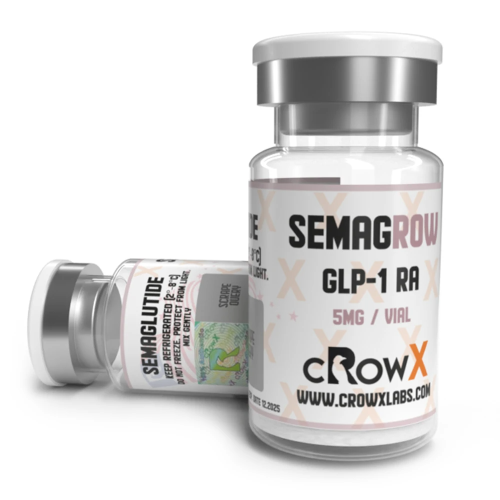Manufacturer: Crowx Labs
Pharmaceutical name: Semaglutide
Pack: 1 vial (5 mg)
Semaglutide is a powerful once-weekly GLP-1 receptor agonist that effectively lowers HbA1c, body weight, and systolic blood pressure. However, it comes with a higher risk of gastrointestinal side effects. Further investigation into its effects on pancreatitis and retinopathy is necessary through post-approval pharmacovigilance studies.
Highlights:
-Research on semaglutide as an appetite suppressor and for weight loss.
-Semaglutide's role in prediabetes
Once-Weekly Semaglutide for Adults with Overweight or Obesity
This phase 3 study was a double-blind, randomized, controlled trial comparing semaglutide with a placebo, alongside lifestyle modifications, in overweight or obese adults without diabetes. A total of 1961 participants were randomized to receive 2.4 mg of subcutaneous semaglutide (with a gradual increase to this dose) or a placebo once a week for 68 weeks; both groups underwent a counseling intervention focusing on diet and exercise. The co-primary endpoints included the percentage change in body weight and weight loss of ≥5%.
Results Efficacy: At week 68, the average weight loss was greater in the semaglutide group compared to placebo (14.9% versus 2.4%; estimated difference of −12.4 percentage points; 95% CI, −13.4 to −11.5). Furthermore, a higher proportion of participants in the semaglutide group achieved weight loss of ≥5% (86.4% vs. 31.5%). Safety: Adverse events, predominantly gastrointestinal, were mostly mild to moderate but resulted in treatment discontinuation in 7.0% of the semaglutide group and 3.1% of the placebo group. Serious adverse events, mainly gastrointestinal and hepatobiliary, occurred more frequently in the semaglutide group.
Conclusions: Overweight or obese adults without diabetes experienced significant weight loss with weekly semaglutide injections (2.4 mg) in conjunction with lifestyle changes.
Semaglutide for Type 2 Diabetes Mellitus: A Systematic Review and Meta-Analysis
This analysis included 6 placebo-controlled and 7 active-controlled studies of subcutaneous semaglutide. We found only 1 trial involving oral semaglutide. When compared to placebo, subcutaneous semaglutide at doses of 0.5 mg and 1 mg reduced HbA1c by 1.01% (95% CI, 0.56-1.47) and 1.38% (1.05-1.70), respectively. Both doses showed better glycemic control than other diabetes medications such as sitagliptin, exenatide, liraglutide, dulaglutide, and insulin glargine.
Semaglutide also positively impacted body weight (mean difference vs placebo −4.11 kg, 95% CI −4.85 to −3.37 for semaglutide 1 mg) and systolic blood pressure. There were no increased rates of hypoglycemia noted with semaglutide; however, higher occurrences of nausea, vomiting, and diarrhea were reported. Cases of pancreatitis were rare, with an odds ratio for diabetic retinopathy of 1.32 (95% CI, 0.98-1.77) when compared to placebo.

